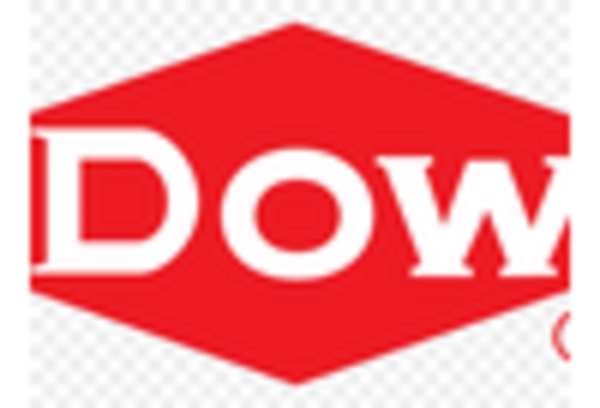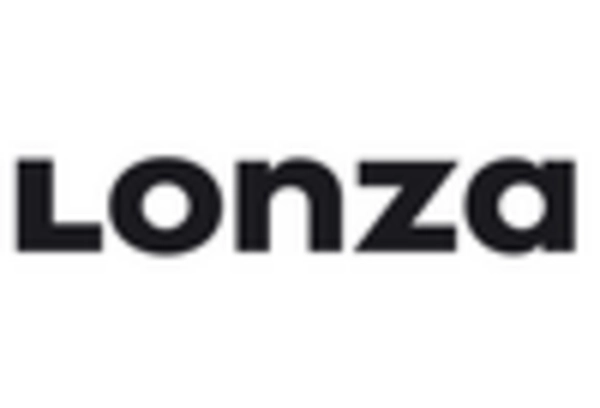Rising Awareness of Skin Health and Safety
The Cosmetic Grade Preservative Market is significantly influenced by the rising awareness of skin health and safety among consumers. As individuals become more conscious of the potential adverse effects of certain chemicals in cosmetics, there is a growing preference for products that utilize safe and effective preservatives. This trend is particularly evident in regions where consumers are increasingly scrutinizing ingredient labels and seeking products that promote skin health. Market data indicates that the demand for products with natural and organic preservatives is on the rise, with a projected increase of 12% in the next few years. Consequently, manufacturers are compelled to reformulate their offerings to include cosmetic grade preservatives that align with these health-conscious consumer preferences, thereby shaping the future of the Cosmetic Grade Preservative Market.
Increasing Demand for Clean Beauty Products
The Cosmetic Grade Preservative Market is witnessing a notable shift towards clean beauty products, driven by consumer preferences for transparency and safety. As consumers become more informed about the ingredients in their cosmetics, there is a growing demand for preservatives that are perceived as safe and non-toxic. This trend is reflected in the market, where the clean beauty segment is projected to grow at a compound annual growth rate of approximately 9% over the next five years. Brands are increasingly reformulating their products to include cosmetic grade preservatives that align with clean beauty standards, thereby enhancing their market appeal. This shift not only influences product development but also encourages manufacturers to innovate and adopt more sustainable practices, ultimately reshaping the Cosmetic Grade Preservative Market.
Expansion of E-commerce and Online Retailing
The expansion of e-commerce and online retailing is reshaping the Cosmetic Grade Preservative Market by providing consumers with greater access to a diverse range of cosmetic products. As online shopping continues to gain popularity, brands are increasingly leveraging digital platforms to reach a wider audience. This shift has led to a surge in the availability of products featuring innovative cosmetic grade preservatives, catering to the growing demand for unique and effective formulations. Market analysis suggests that e-commerce sales in the beauty sector are expected to grow by approximately 20% annually, indicating a robust opportunity for brands to capitalize on this trend. As a result, manufacturers are focusing on enhancing their online presence and optimizing their product offerings to meet the evolving preferences of consumers in the Cosmetic Grade Preservative Market.
Regulatory Pressures and Compliance Requirements
Regulatory pressures and compliance requirements are becoming increasingly stringent within the Cosmetic Grade Preservative Market, compelling manufacturers to adhere to higher safety and efficacy standards. Governments and regulatory bodies are implementing more rigorous guidelines regarding the use of preservatives in cosmetics, which has a direct impact on product formulation and market dynamics. Companies are now required to invest in compliance measures and ensure that their products meet these evolving regulations. This trend is expected to drive innovation in the development of safer and more effective cosmetic grade preservatives, as brands seek to maintain market access while ensuring consumer safety. The market is likely to see a shift towards preservatives that not only comply with regulations but also align with consumer expectations for safety and sustainability, thereby influencing the future landscape of the Cosmetic Grade Preservative Market.
Technological Advancements in Preservation Techniques
Technological advancements are playing a crucial role in the Cosmetic Grade Preservative Market, as new preservation techniques emerge to meet evolving consumer demands. Innovations such as encapsulation technology and the use of bio-based preservatives are gaining traction, allowing for more effective and safer preservation methods. These advancements not only enhance the efficacy of preservatives but also extend the shelf life of cosmetic products, which is a critical factor for manufacturers. The market for bio-based preservatives is expected to grow significantly, with estimates suggesting a rise of over 15% in the next few years. As a result, companies are increasingly investing in research and development to explore these new technologies, thereby driving growth within the Cosmetic Grade Preservative Market.


















Leave a Comment